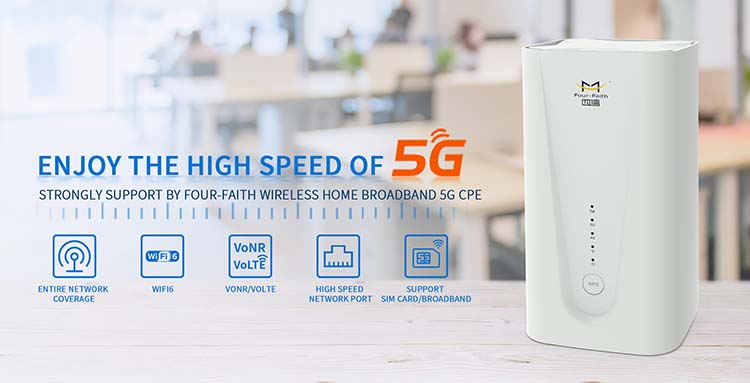The difference between 5g router and 2.4g router of industrial routers lies in the difference in wifi frequency bands. What is the specific difference between the 5g and 2.4g wifi frequency bands?
We usually use WiFi. As we all know, WiFi is transmitted through radio waves. But how is WiFi different from OTA TV, radio, and radar? When comparing 2.4g router GHz and 5g router GHz WiFi, you will find that each frequency band has its own advantages and disadvantages. WiFi requirements will determine which radio frequency is best for your wireless device.
First, we must point out that, like the term "T1", "5 GHz" is a bit misnomer, because the spectrum used actually spans 5.18 GHz to 5.825 GHz.
What is WiFi?
Wi-Fi® is a registered trademark of the Wi-Fi Alliance Trade Association, and is a series of standards used by manufacturers to certify the WiFi interoperability of their wireless products. The WiFi standard is overseen by the Institute of Electrical and Electronics Engineers (IEEE). The Wi-Fi Alliance and IEEE are different organizations. As the VCE guidelines point out, IEEE is "responsible for the development of standards applicable to wireless networks", and the Wi-Fi Alliance is "an organization that regulates compliance with...radio frequency and transmission power level regulations and standards on a global scale."
WiFi is based on a series of wireless local area network (WLAN) protocols called IEEE 802.11, which standardizes the communication between wireless hosts (e.g., base stations, access points, and industrial routers) and wireless clients (e.g., laptop computers and mobile devices). The radio interface between wireless clients (for example, Bluetooth and WiFi Direct).
Broadcast (OTA) TV and radio, radar and WiFi
OTA TV transmits three separate spectra across radio frequencies: 54-88 MHz (VHF channels 2-6), 174-216 MHz (VHF channels 7-13), and 470-890 MHz (UHF channels 14-83). The range between the radio frequency in the 10 kHz range of 535-1605 kHz and the FM radio equipment that spans the frequency in the range of 200 kHz on AM radio broadcasts ranges from 88.1 MHz to 108.1 MHz.
A keen reader will notice that the FM radio frequency lies between the spectrum reserved for VHF TV channels 2-6 and VHF channels 7-13.
However, the radar problem is even greater. Many radar devices transmit via the same 5g router GHz used by home WiFi, which means there is a possibility of interference. Therefore, 802.11a/n/ac/ax WiFi networks require dynamic frequency selection (DFS), which is a spectrum sharing process.
DFS checks channel availability and looks for the presence of radar signals, depending on the area, it may take up to 10 minutes. If it is not detected, the channel is indicated as "available". If a radar is detected ("In-Service Monitoring"), DFS requires the network to wait up to 30 minutes and then try to use the WiFi channel again.
Fortunately, not all 5 GHz channels are restricted by DFS. But this is why when the Wi-Fi network is activated, users can immediately access 2.4g router GHz and the availability of 5g router GHz is delayed.
Wireless range
When comparing 2.4g router GHz and 5g router GHz WiFi, the main contrast between the two is range and speed. We compared the 2.4g router GHz and 5g router GHz above; the following is the difference in WiFi range. Of course, in radio propagation, the path loss will increase as the frequency increases. The same is true for materials. The "attenuation value" of 2.4 GHz is very different from that of 5 GHz. Ibwave.com found (unsurprisingly) that when it penetrates 40-year-old concrete, the transmission loss at 5 GHz is approximately twice that of 2.4 GHz. Even different types of glass will affect the attenuation rate. For example, the 2.4g router GHz and 5g router GHz attenuation rates of white ceramic glass (such as coffee cups and cooktops) and electronic device glass (such as those used in transistor fuses) are similar (and relatively low). However, the attenuation rate of traditional glass will increase and diverge, while the attenuation rate of Low-e glass will increase exponentially, which will greatly reduce the penetration of ultraviolet, infrared and radio waves.
The range limitations of 5g router GHz WiFi led to the emergence of mesh networks and extender kits. These systems can reach the home’s WiFi blind zone, where 2.4g router GHz could be reached but 5 GHz could not be reached.
As mentioned above, the main disadvantage of 2.4g router GHz is its susceptibility to radio interference. If you use an 802.11g laptop, your computer will compete with IoT devices, Bluetooth, microwave ovens, etc. for 2.4 GHz bandwidth.
In the United States, WiFi users have only 11 channels (13 in Europe) in the 2.4 GHz band with 20 MHz width available. To make matters worse, since the 2.4 GHz spectrum is only 100 MHz wide, most of the 2.4g router GHz channels overlap. In the United States and Europe, only three 2.4 GHz channels (1, 6, 11) do not overlap.
In contrast, 5g router GHz has 25 non-overlapping 20 MHz wide channels. Those who desire higher data speeds can bond channels to create wider 40 MHz or 80 MHz data paths. But doing so will reduce the number of 5 GHz data paths. In densely populated areas-apartment buildings or office buildings-bonding 5 GHz channels can cause the same congestion as 2.4 GHz.
The answer depends on the needs of the project. Generally, the more terminals are used in the project, the higher the frequency band selection, and the more equipment used.

